-
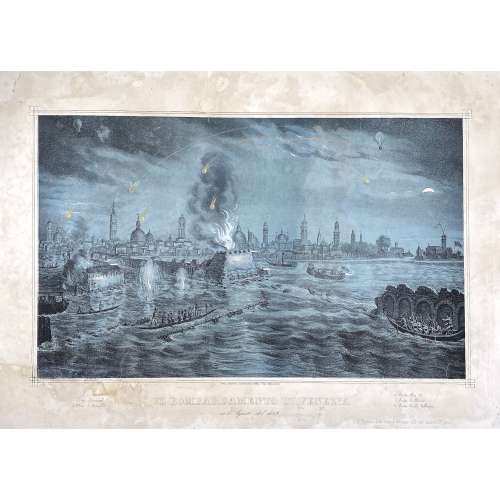 Quaritch's description: Single sheet (435 x 625 mm); coloured lithograph by Kirchmayr after a drawing by M. Fontana; hand-painted details; signed to lower left ‘M. Fon[tana]’ and to lower right ‘M. Fontana Edit. Prop. S. Giacomo dall’Orio in Isola N°.1481’; lower margin with the title ‘Il bombardamento di Venezia nell’Agosto 1849’ and key; restored tears in many places, especially along upper and lower blank margins, some affecting print; losses to lower left corner, affecting a small portion of the print, ruled border, and key, restored and re-drawn where needed; loss to the upper left corner of blank margin; two small areas of restoration to the centre of upper blank margin; the whole sheet backed; nevertheless a remarkable survival. Exceedingly rare and striking lithograph of Venice as seen from Fusina, depicting the first ever aerial bombardment in history. The bombardment took place in 1849, under the orders of Field Marshal Josef Radetzky (1766–1858), to quell the revolts that had started the previous year during the First Italian War of Independence. This curious and little-known action was the brainchild of Colonel Benno Uchatius, a brilliant young officer in the Austro-Hungarian Artillery. After long months of unsuccessful siege, Uchatius decided to deploy an unusual weapon: a hot air balloon able to bomb the city from above. Having calculated the wind speed and direction and evaluated the requisite dimensions of the hot-air balloon, Uchatius set up a workshop near Mestre, where a group of engineers and craftsmen began to manufacture a balloon equipped with a large wicker basket which could transport two crewmen and approximately one hundred kilograms of small long-fuse devices (metal spheres filled with gunpowder, pitch, oil and five hundred rifle buckshot). The initial trials, however, proved to be a disaster, because the balloon would drift off course, making it impossible to accurately deploy the bombs. Uchatius then hit upon the idea of using several smaller unmanned balloons roped together. These were to be launched over the city and, using the position of the first ‘pilot’ balloon, which was unarmed, the Austrians could calculate the correct fuse settings for the bombs. The ‘bomber’ balloons had a cloth envelope of one hundred cubic metres and a reduced load of about twenty kilograms of ordnance. According to Uchatius’ calculations, the line of balloons, launched from Mestre, would reach the lagoon city in thirty-five to forty minutes, carried by the north-west wind. In July 1849, a first launch was attempted, but when a breeze began to blow from the sea some of the balloons broke the connecting ropes and floated away, while others settled in the water in front of the northern part of the city, where a curious crowd of Venetians observed the failure of the enterprise and commented colourfully on the ‘buffoonery of Radetzky’. Uchatius’ second attempt, which is depicted in this lithograph, was also largely unsuccessful: only a few of the unmanned bomber balloons reached their target, and some even drifted back over the Austrian lines. Uchatius, having accomplished the first ever aerial bombardment, and having designed the first ever military ‘drones’, was forced to abandon the project permanently. Another fascinating aspect of this work is the vantage point used to depict the city of Venice, seen here from Fusina, a very rare viewpoint that makes this piece even more remarkable. We were unable to locate any copies in any institution or bibliography. G. Kirchmayr (fl. mid-19th century) is mentioned at British Museum database as "Lithographer active in Venice; related to Venetian painter Cherubino Kirchmayr (b. 1848)?" However, I was not able to find that name on the print. Not much is known of M. Fontana either.
Quaritch's description: Single sheet (435 x 625 mm); coloured lithograph by Kirchmayr after a drawing by M. Fontana; hand-painted details; signed to lower left ‘M. Fon[tana]’ and to lower right ‘M. Fontana Edit. Prop. S. Giacomo dall’Orio in Isola N°.1481’; lower margin with the title ‘Il bombardamento di Venezia nell’Agosto 1849’ and key; restored tears in many places, especially along upper and lower blank margins, some affecting print; losses to lower left corner, affecting a small portion of the print, ruled border, and key, restored and re-drawn where needed; loss to the upper left corner of blank margin; two small areas of restoration to the centre of upper blank margin; the whole sheet backed; nevertheless a remarkable survival. Exceedingly rare and striking lithograph of Venice as seen from Fusina, depicting the first ever aerial bombardment in history. The bombardment took place in 1849, under the orders of Field Marshal Josef Radetzky (1766–1858), to quell the revolts that had started the previous year during the First Italian War of Independence. This curious and little-known action was the brainchild of Colonel Benno Uchatius, a brilliant young officer in the Austro-Hungarian Artillery. After long months of unsuccessful siege, Uchatius decided to deploy an unusual weapon: a hot air balloon able to bomb the city from above. Having calculated the wind speed and direction and evaluated the requisite dimensions of the hot-air balloon, Uchatius set up a workshop near Mestre, where a group of engineers and craftsmen began to manufacture a balloon equipped with a large wicker basket which could transport two crewmen and approximately one hundred kilograms of small long-fuse devices (metal spheres filled with gunpowder, pitch, oil and five hundred rifle buckshot). The initial trials, however, proved to be a disaster, because the balloon would drift off course, making it impossible to accurately deploy the bombs. Uchatius then hit upon the idea of using several smaller unmanned balloons roped together. These were to be launched over the city and, using the position of the first ‘pilot’ balloon, which was unarmed, the Austrians could calculate the correct fuse settings for the bombs. The ‘bomber’ balloons had a cloth envelope of one hundred cubic metres and a reduced load of about twenty kilograms of ordnance. According to Uchatius’ calculations, the line of balloons, launched from Mestre, would reach the lagoon city in thirty-five to forty minutes, carried by the north-west wind. In July 1849, a first launch was attempted, but when a breeze began to blow from the sea some of the balloons broke the connecting ropes and floated away, while others settled in the water in front of the northern part of the city, where a curious crowd of Venetians observed the failure of the enterprise and commented colourfully on the ‘buffoonery of Radetzky’. Uchatius’ second attempt, which is depicted in this lithograph, was also largely unsuccessful: only a few of the unmanned bomber balloons reached their target, and some even drifted back over the Austrian lines. Uchatius, having accomplished the first ever aerial bombardment, and having designed the first ever military ‘drones’, was forced to abandon the project permanently. Another fascinating aspect of this work is the vantage point used to depict the city of Venice, seen here from Fusina, a very rare viewpoint that makes this piece even more remarkable. We were unable to locate any copies in any institution or bibliography. G. Kirchmayr (fl. mid-19th century) is mentioned at British Museum database as "Lithographer active in Venice; related to Venetian painter Cherubino Kirchmayr (b. 1848)?" However, I was not able to find that name on the print. Not much is known of M. Fontana either. -
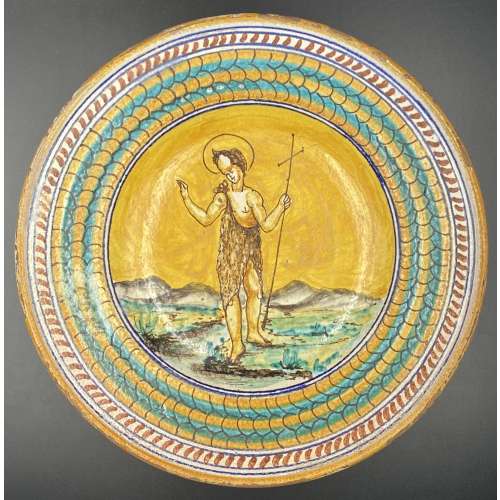 Tin-glazed earthenware polychrome plate of round form, decorated with a figure of John the Baptist wearing clothes of camel's hair with a tall cross in his left hand and with a halo over his head, walking in a desert with hills on the background. The lip is decorated with circles and scales, base with concentric circles. Diameter: 23 cm; Height: 4 cm.
Tin-glazed earthenware polychrome plate of round form, decorated with a figure of John the Baptist wearing clothes of camel's hair with a tall cross in his left hand and with a halo over his head, walking in a desert with hills on the background. The lip is decorated with circles and scales, base with concentric circles. Diameter: 23 cm; Height: 4 cm. -
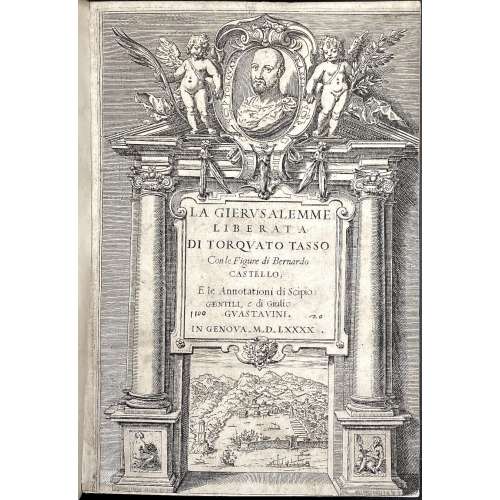 Engraved title with the portrait of Torquato Tasso, displayed in an oval medallion, bound in “TORQUATO TASSO”, between two naked putti; Architecture with two columns and Ionic capitals supporting an architectural pediment; between the columns is a table with the inscription: LA GIERVSALEMME | LIBERATA | DI TORQVATO TASSO | Con le Figure di Bernardo | CASTELLO; | E le Annotazioni di Scipio | GENTILI, e di Giulio | GVASTAVINI. | IN GENOVA. M.D.LXXXX .|| Contents: The 20 cantos are followed by: Tutte le stanza intere, che dall'autore sono state refiutate in questo libro; Annotationi di Scipio Gentili; Luoghi osservati dal mag. Giulio Guastavini, quali il Tasso nella sua Gierusalemme hà presi & imitati da poeti & altri scrittori antichi; Allegoria del poema; Tavola di tutti i nomi proprii et di tutte le materie principali contenute nel presente libro. Pagination: [2] engraved t.p. / blank, 3-11, [1] 2-255 [256], 1-71 [72] [1] 2-40, 4 unpag. leaves ‘Allegoria del poema’; total 387 pp. Collation: 8vo; π6 A-Q8 A-D8 E4 A-B8 χ4 (in the first quire M4 marked L4), ills. signed in collation. At p. 17 canto 3rd marked as 2nd, pp. 135 and 139 in 12th canto marked as 11th. Binding: later full polished calf, blind double-ruled covers, blind double-ruled raised bands, gilt lettering: GIERVSALEMME | LIBERATA and GENOVA | 1590. TMG. Printed on laid paper. Front joints split at head and tail. Title page and twenty full-page ill. facing the opening of each canto, engraved by Agostino Carracci and Giacomo Franco after Castello. Those for cantos 6-8, 10, 12, 16-17, 19-20 are by Carracci, 8 and 19 with his initials. The remainder are by Franco and are signed by him. Woodcut head and tailpieces, the Argomenti at the head of each canto within cartouches, initials. Catalogue raisonné: Adam Bartsch. Le peintre graveur. — Vienne: J. V. Degen, 1803.
Engraved title with the portrait of Torquato Tasso, displayed in an oval medallion, bound in “TORQUATO TASSO”, between two naked putti; Architecture with two columns and Ionic capitals supporting an architectural pediment; between the columns is a table with the inscription: LA GIERVSALEMME | LIBERATA | DI TORQVATO TASSO | Con le Figure di Bernardo | CASTELLO; | E le Annotazioni di Scipio | GENTILI, e di Giulio | GVASTAVINI. | IN GENOVA. M.D.LXXXX .|| Contents: The 20 cantos are followed by: Tutte le stanza intere, che dall'autore sono state refiutate in questo libro; Annotationi di Scipio Gentili; Luoghi osservati dal mag. Giulio Guastavini, quali il Tasso nella sua Gierusalemme hà presi & imitati da poeti & altri scrittori antichi; Allegoria del poema; Tavola di tutti i nomi proprii et di tutte le materie principali contenute nel presente libro. Pagination: [2] engraved t.p. / blank, 3-11, [1] 2-255 [256], 1-71 [72] [1] 2-40, 4 unpag. leaves ‘Allegoria del poema’; total 387 pp. Collation: 8vo; π6 A-Q8 A-D8 E4 A-B8 χ4 (in the first quire M4 marked L4), ills. signed in collation. At p. 17 canto 3rd marked as 2nd, pp. 135 and 139 in 12th canto marked as 11th. Binding: later full polished calf, blind double-ruled covers, blind double-ruled raised bands, gilt lettering: GIERVSALEMME | LIBERATA and GENOVA | 1590. TMG. Printed on laid paper. Front joints split at head and tail. Title page and twenty full-page ill. facing the opening of each canto, engraved by Agostino Carracci and Giacomo Franco after Castello. Those for cantos 6-8, 10, 12, 16-17, 19-20 are by Carracci, 8 and 19 with his initials. The remainder are by Franco and are signed by him. Woodcut head and tailpieces, the Argomenti at the head of each canto within cartouches, initials. Catalogue raisonné: Adam Bartsch. Le peintre graveur. — Vienne: J. V. Degen, 1803.Author: Written by Torquato Tasso (Italian, Sorrento 1544–1595 Rome)
Designer: Illustrations designed by Bernardo Castello (Italian, Genoa (?) 1557–1629 Genoa)
Engraver: Illustrations engraved by Agostino Carracci (Italian, Bologna 1557–1602 Parma)
Engraver: Illustrations engraved by Giacomo Franco (Italian, Venice 1550–1620 Venice)
Publisher: Published by Girolamo Bartoli , Genoa
Ref.: MET, HathiTrust, -
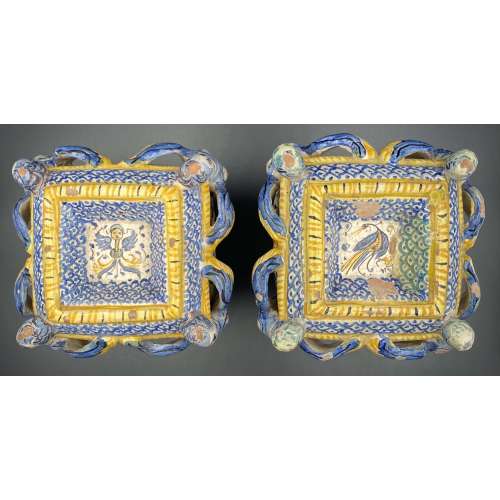 Tin-glazed earthenware salt cellars decorated with winged creatures and grotesque paintings. Restored, losses. Size: 16 x 16 cm; Height: 2.5 cm. Attributed to Deruta, Italy, c. 1600.
Tin-glazed earthenware salt cellars decorated with winged creatures and grotesque paintings. Restored, losses. Size: 16 x 16 cm; Height: 2.5 cm. Attributed to Deruta, Italy, c. 1600. -
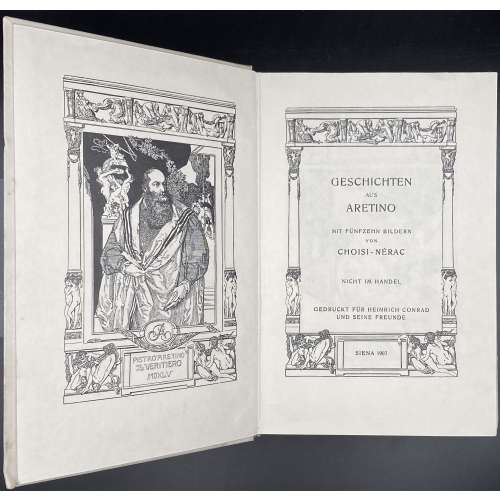 Title: GESCHICHTEN | AUS | ARETINO | MIT FÜNFZEHN BILDERN | VON | CHOISI-NÉRAC | NICHT IM HANDEL | GEDRUCKT FÜR HEINRICH CONRAD | UND SEINE FREUNDE | SIENA 1907 || Collation: 8vo; 1-128 137; frontispiece, t.p. and 14 plates, extraneous to collation. Pagination: [2] f.t. / blank, 3-203 [2], il. Binding: Full cream vellum, ruled with gilt double-fillet, grey label with gilt lettering to spine. Bookplate by von Bayros Par Avi Cigno to front pastedown. Note: Private edition of Aretino's Ragionamenti in German as Geschichten aus Aretino by translater and publisher Heinrich Conrad (German, 1866 – 1918), whose real name was Hugo Storm, this copy №394, illustrated by Franz von Bayros (Austrian, 1866 – of Choisi-Nérac.
Title: GESCHICHTEN | AUS | ARETINO | MIT FÜNFZEHN BILDERN | VON | CHOISI-NÉRAC | NICHT IM HANDEL | GEDRUCKT FÜR HEINRICH CONRAD | UND SEINE FREUNDE | SIENA 1907 || Collation: 8vo; 1-128 137; frontispiece, t.p. and 14 plates, extraneous to collation. Pagination: [2] f.t. / blank, 3-203 [2], il. Binding: Full cream vellum, ruled with gilt double-fillet, grey label with gilt lettering to spine. Bookplate by von Bayros Par Avi Cigno to front pastedown. Note: Private edition of Aretino's Ragionamenti in German as Geschichten aus Aretino by translater and publisher Heinrich Conrad (German, 1866 – 1918), whose real name was Hugo Storm, this copy №394, illustrated by Franz von Bayros (Austrian, 1866 – of Choisi-Nérac. -
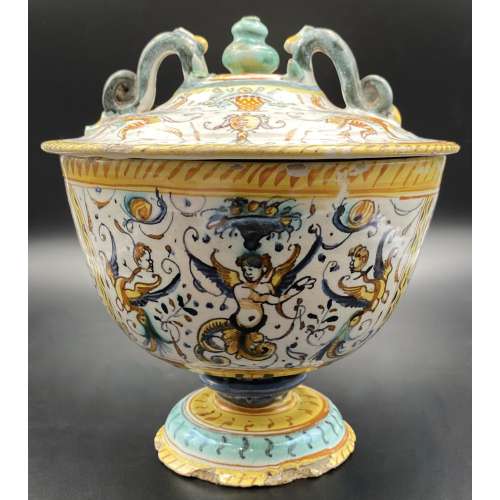 Tin-glazed earthenware footed lidded cup decorated with winged creatures and grotesque paintings, Bachus and Cupid inside. Minor losses Diameter: 16 cm; Height: 18 cm. Attributed to Deruta, Italy, c. 1600.
Tin-glazed earthenware footed lidded cup decorated with winged creatures and grotesque paintings, Bachus and Cupid inside. Minor losses Diameter: 16 cm; Height: 18 cm. Attributed to Deruta, Italy, c. 1600. -
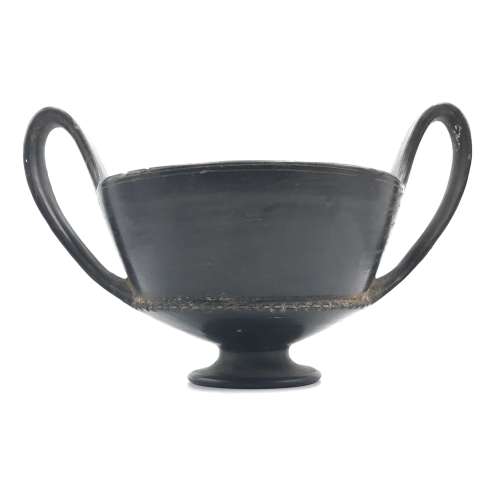 Etruscan Bucchero Pottery Kantharos, ca. 758-264 BC. A ceramic vessel with high handles, meant for consuming wine. Flanged border between the body and the foot displays dozens of incised grooves. The rim is smooth, and the upper and of each handle flows seamlessly into the body if the vessel. Bucchero is an Etruscan type of pottery named for the specific firing technique which results in a smooth, shiny black finish. Size: 21.6 x 13.3 cm. Portions os both handles repaired with some overpainting and light adhesive residue along break lines, One handle stabilized with some new material and overpainting along fissure line. Light earthen deposits within recessed areas.
Etruscan Bucchero Pottery Kantharos, ca. 758-264 BC. A ceramic vessel with high handles, meant for consuming wine. Flanged border between the body and the foot displays dozens of incised grooves. The rim is smooth, and the upper and of each handle flows seamlessly into the body if the vessel. Bucchero is an Etruscan type of pottery named for the specific firing technique which results in a smooth, shiny black finish. Size: 21.6 x 13.3 cm. Portions os both handles repaired with some overpainting and light adhesive residue along break lines, One handle stabilized with some new material and overpainting along fissure line. Light earthen deposits within recessed areas. -
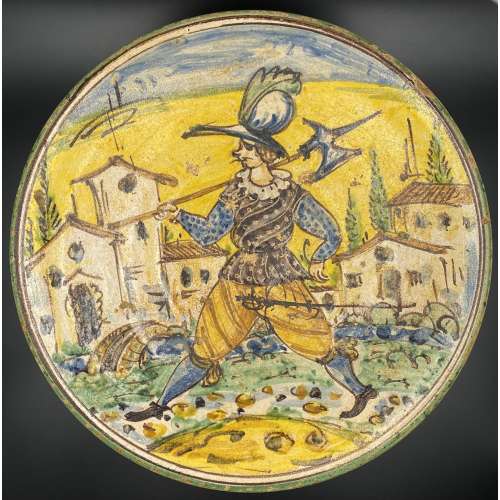 Footed round dish depicting a gentleman in an urban landscape holding a halberd in a style of "Arlecchino di Montelupo". Unsigned. Chips to the bottom. Diameter: 32.5 cm; Height: 4.5 cm. Produced in Italy, in Montelupo, about 20 kilometres (12 miles) southwest of Florence. 17th century, probably the first half. "After 1630, the year of the great plague, the number of potters reduced considerably and in the second half of the 1600s production suffered a drastic slump, potteries that specialized in a more prestigious production disappeared completely leaving only the potteries that produced kitchenware and terracotta objects" [www.tuscany-charming.it].
Footed round dish depicting a gentleman in an urban landscape holding a halberd in a style of "Arlecchino di Montelupo". Unsigned. Chips to the bottom. Diameter: 32.5 cm; Height: 4.5 cm. Produced in Italy, in Montelupo, about 20 kilometres (12 miles) southwest of Florence. 17th century, probably the first half. "After 1630, the year of the great plague, the number of potters reduced considerably and in the second half of the 1600s production suffered a drastic slump, potteries that specialized in a more prestigious production disappeared completely leaving only the potteries that produced kitchenware and terracotta objects" [www.tuscany-charming.it]. -
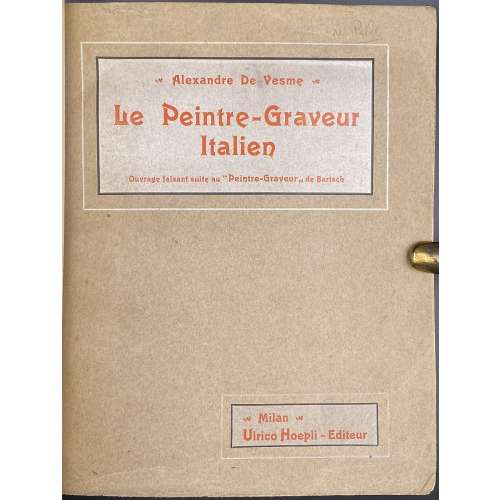 Description: 4to, 26 x 21 cm, hardcover ¾ brown percaline over marbled boards, gilt lettering to spine, marbled endpapers, publisher’s original wrappers preserved (bound-in), engraved bookplate “EX LIBRIS | Rodolfo …“ to verso of the 1st blank leaf. Printed in 1905 by Imprimerie Humbert Allegretti (Milan). Collation: 4to; front wrapper, π3 (blank, h.t., t.p.), 1-684, back wrapper; total 275 leaves within the wrappers. Pagination: [6] [1] 2-542 [2], total 550 pages. Contributors: Alessandro Baudi di Vesme [Alexandre de Vesme] (Italian, 1854 – 1923) Adam Bartsch (Austrian, 1757 – 1821) Ulrico Hoepli [Johannes Ulrich Höpli] (Swiss-Italian, 1846 – 1935) U. Hoepli (Milan)
Description: 4to, 26 x 21 cm, hardcover ¾ brown percaline over marbled boards, gilt lettering to spine, marbled endpapers, publisher’s original wrappers preserved (bound-in), engraved bookplate “EX LIBRIS | Rodolfo …“ to verso of the 1st blank leaf. Printed in 1905 by Imprimerie Humbert Allegretti (Milan). Collation: 4to; front wrapper, π3 (blank, h.t., t.p.), 1-684, back wrapper; total 275 leaves within the wrappers. Pagination: [6] [1] 2-542 [2], total 550 pages. Contributors: Alessandro Baudi di Vesme [Alexandre de Vesme] (Italian, 1854 – 1923) Adam Bartsch (Austrian, 1757 – 1821) Ulrico Hoepli [Johannes Ulrich Höpli] (Swiss-Italian, 1846 – 1935) U. Hoepli (Milan) -
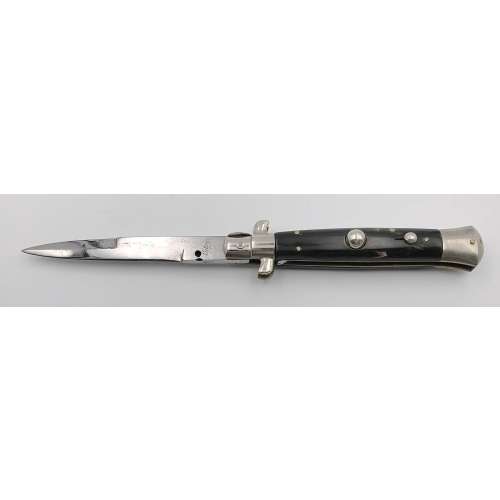
Classical picklock Italian stiletto switchblade knife with bolster release, fixed guard, Brazilian horn handle.
Size: 112 mm (closed); 240 mm (opened); 90 mm blade.
Tang is etched with: Latama, Italy. SOLD -
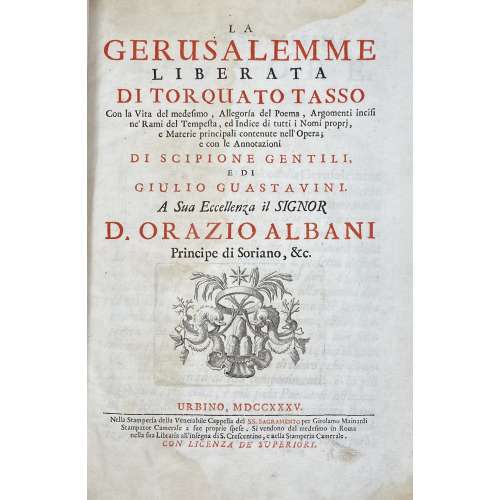 Title page (in red and black): LA | GERUSALEMME | LIBERATA | DI TORQUATO TASSO | Con la Vita del medesimo , Allegoria del Poema , Argomenti incisi | ne’Rami del Tempesta , ed Indice di tutti i Nomi proprj , | e Materie principali contenute nell’Opera ; | e con le Annotazioni | DI SCIPIONE GENTILI | E DI | GIULIO GUASTAVINI. | A Sua Eccellenza il SIGNOR | D. ORAZIO ALBANI | Principe di Soriano, &c. | {printer’s device} | URBINO, MDCCXXXV. | — | Nella Stamperia della Venerabile Cappella del SS. SAGRAMENTO per Girolamo Mainardi | Stampator Camerale a sue proprie spese . Si vendono dal medesimo in Roma | nella sua Libraria all’insegna di S. Crescentino, e nella Stamperia Camerale | CON LICENZA DE SUPERIORI. || Half-title: Title page: IL | GOFFREDO | OVVERO | LA GERUSALEMME | LIBERATA | DI | TORQUATO TASSO. || Collation: 4to; [2] blank leaves, [1] – h.t. / blank, [1] – t.p. / blank, [1] – dedication signed *2, [2] – vita, 1st signed *3, [2] – allegoria, [3] – indice, first two signed ** and **2, respectively, [1] – frontispiece to Canto Primo —> total 13 prelims; π13 (incl. 2 blanks), A-Z4 Aa-Bb4 Cc6 Dd-Qq4, χ1 (blank); 20 engraved frontispieces, one headpiece and initials, some historiated. Frontis. to Cantos II-XX incl. in collation and pagination; the number of leaves from A1 to Qq4 = 158; pagination: 1-316. The total number of leaves incl. prelims and blanks = 172. Note: three first leaves in the Cc quire of six leaves are signed; all other four-leaf quires only have the first two first leaves signed. Frontispiece to Canto Quarto cut down and laid down on D2v (as in Christie’s copy sold on 6 Jun 2010 – Live Auction 5475 – Fine Printed Books and Manuscripts, lot 168, price realized GBP 600). Illustrations: Frontispiece to Canto Primo signed “Arnoldo van Westerhout formis Roma”. Headpiece to Canto Primo signed “Eq. Petrus Leo Ghezius Inu. et. delin. — Frãn. Aquila incid.” Other plates unsigned but all attributed to Westerhout after Antonio Tempesta; Numeration of frontispieces in roman numbers, IIII for VI, VIIII for IX, XIIII for XIV, inverted numbers XVII, XVIII, and XIX, respectively: IIVX, IIIVX, and IIIIVX. Binding: 35 x 24 cm, 34 x 23 cm leaves, contemporary calf, rebacked retaining original spine, verso front flyleaf stamped “RESTORED BY MACDONALD CO. | NORWALK. CONN. Marbled endpapers, all edges red. Speckled calf, gilt triple-fillet borders, with remnants of blind-stamped and gilt design to an upper inside corner, spine with raised bands, gilt acorn tooling in compartments, later crimson label with gilt lettering. Damp staining to inside edges affecting all leaves. The Robin Collection bookplate to front pastedown. Provenance: The Robin Collection. Contributors: Torquato Tasso (Italian, 1544 –1595) – author. Scipione Gentili [Scipio Gentilis] (Italian, 1563 – 1616) Giulio Guastavini (Italian, fl. 16th century) Antonio Tempesta [Tempestino] (Italian, 1555 – 1630) – artist. Arnold [Arnoldo] van Westerhout (Flemish, 1651 – 1725) – artist, engraver. Pier Leone Ghezzi (Italian, 1674 – 1755) – artist. Francesco Faraone Aquila (Italian, c. 1676 – c. 1740) – engraver. Girolamo Mainardi (Italian, c. 1679 circa – 1763) – printer, publisher. Orazio Albani (Italian, 1576 – 1653) – dedicatee.
Title page (in red and black): LA | GERUSALEMME | LIBERATA | DI TORQUATO TASSO | Con la Vita del medesimo , Allegoria del Poema , Argomenti incisi | ne’Rami del Tempesta , ed Indice di tutti i Nomi proprj , | e Materie principali contenute nell’Opera ; | e con le Annotazioni | DI SCIPIONE GENTILI | E DI | GIULIO GUASTAVINI. | A Sua Eccellenza il SIGNOR | D. ORAZIO ALBANI | Principe di Soriano, &c. | {printer’s device} | URBINO, MDCCXXXV. | — | Nella Stamperia della Venerabile Cappella del SS. SAGRAMENTO per Girolamo Mainardi | Stampator Camerale a sue proprie spese . Si vendono dal medesimo in Roma | nella sua Libraria all’insegna di S. Crescentino, e nella Stamperia Camerale | CON LICENZA DE SUPERIORI. || Half-title: Title page: IL | GOFFREDO | OVVERO | LA GERUSALEMME | LIBERATA | DI | TORQUATO TASSO. || Collation: 4to; [2] blank leaves, [1] – h.t. / blank, [1] – t.p. / blank, [1] – dedication signed *2, [2] – vita, 1st signed *3, [2] – allegoria, [3] – indice, first two signed ** and **2, respectively, [1] – frontispiece to Canto Primo —> total 13 prelims; π13 (incl. 2 blanks), A-Z4 Aa-Bb4 Cc6 Dd-Qq4, χ1 (blank); 20 engraved frontispieces, one headpiece and initials, some historiated. Frontis. to Cantos II-XX incl. in collation and pagination; the number of leaves from A1 to Qq4 = 158; pagination: 1-316. The total number of leaves incl. prelims and blanks = 172. Note: three first leaves in the Cc quire of six leaves are signed; all other four-leaf quires only have the first two first leaves signed. Frontispiece to Canto Quarto cut down and laid down on D2v (as in Christie’s copy sold on 6 Jun 2010 – Live Auction 5475 – Fine Printed Books and Manuscripts, lot 168, price realized GBP 600). Illustrations: Frontispiece to Canto Primo signed “Arnoldo van Westerhout formis Roma”. Headpiece to Canto Primo signed “Eq. Petrus Leo Ghezius Inu. et. delin. — Frãn. Aquila incid.” Other plates unsigned but all attributed to Westerhout after Antonio Tempesta; Numeration of frontispieces in roman numbers, IIII for VI, VIIII for IX, XIIII for XIV, inverted numbers XVII, XVIII, and XIX, respectively: IIVX, IIIVX, and IIIIVX. Binding: 35 x 24 cm, 34 x 23 cm leaves, contemporary calf, rebacked retaining original spine, verso front flyleaf stamped “RESTORED BY MACDONALD CO. | NORWALK. CONN. Marbled endpapers, all edges red. Speckled calf, gilt triple-fillet borders, with remnants of blind-stamped and gilt design to an upper inside corner, spine with raised bands, gilt acorn tooling in compartments, later crimson label with gilt lettering. Damp staining to inside edges affecting all leaves. The Robin Collection bookplate to front pastedown. Provenance: The Robin Collection. Contributors: Torquato Tasso (Italian, 1544 –1595) – author. Scipione Gentili [Scipio Gentilis] (Italian, 1563 – 1616) Giulio Guastavini (Italian, fl. 16th century) Antonio Tempesta [Tempestino] (Italian, 1555 – 1630) – artist. Arnold [Arnoldo] van Westerhout (Flemish, 1651 – 1725) – artist, engraver. Pier Leone Ghezzi (Italian, 1674 – 1755) – artist. Francesco Faraone Aquila (Italian, c. 1676 – c. 1740) – engraver. Girolamo Mainardi (Italian, c. 1679 circa – 1763) – printer, publisher. Orazio Albani (Italian, 1576 – 1653) – dedicatee. -
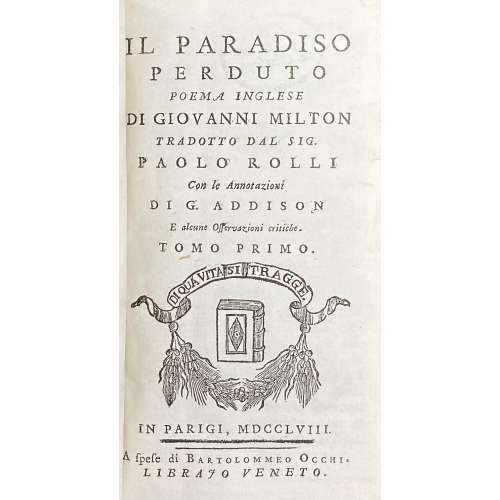 Quarter calf over marbled boards, 16 x 9 cm, spine with raised bands, gilt in compartments, gilt-lettered label, all margins red, two title-pages (one for each vol.), illustrated with engraved frontispiece by Antonio Baratti after Antonio Balestra; engraved portrait of John Milton by Antonio Baratti, 12 plates, one for each book, after “Piazzetta, Zucchi, Balestra, Tiepolo, and other Venetian artists”, unsigned; plate II signed ‘Antonio Barati scul.’ Title page: IL PARADISO | PERDUTO | POEMA INGLESE | DI GIOVANNI MILTON | TRADOTTO DAL SIG. | PAOLO ROLLI | Con le Annotazioni | DI G. ADDISON | E alcune Osservazioni critiche. | TOMO PRIMO (SECUNDO). | {publisher’s device} | IN PARIGI , MDCCLVIII. | — | A spese di Bartolommeo Occhi. | LIBRAJO VENETO. || Collation: *-**12 ***8 (dedication, vita), A-R12 (vol. 1) A-K12 L9 (vol.2); total 365 leaves plus 14 engraved plates, incl. frontispiece and portrait. Pagination: [i, ii] iii-lxiv 1-407 [408 blank], [2] 3-258; total 730 pages. Catalogue raisonné: Wickenheiser Collection 688 [LIB-2795.2021]. Though it states 228 pp., which does not seem right. “Scarce. Not in Coleridge”. Contributors: Milton, John (British, 1608 – 1674) – author. Joseph Addison (British, 1672 – 1719) – author / criticism Paolo Antonio Rolli (Italian, 1687 – 1765) – author / transaltion Bartolomeo Occhi (Italian, 1730 – 1781) – publisher. Antonio Baratti (Italian, 1724 – 1787) – engraver Antonio Balestra (Italian, 1666 – 1740) – artist. Giovanni Battista Piazzetta (Italian,1682/83 – 1754) – artist. Antonio Zucchi (Italian, 1726 – 1795) – artist. Giovanni Battista Tiepolo (Italian, 1696 – 1770) – artist.
Quarter calf over marbled boards, 16 x 9 cm, spine with raised bands, gilt in compartments, gilt-lettered label, all margins red, two title-pages (one for each vol.), illustrated with engraved frontispiece by Antonio Baratti after Antonio Balestra; engraved portrait of John Milton by Antonio Baratti, 12 plates, one for each book, after “Piazzetta, Zucchi, Balestra, Tiepolo, and other Venetian artists”, unsigned; plate II signed ‘Antonio Barati scul.’ Title page: IL PARADISO | PERDUTO | POEMA INGLESE | DI GIOVANNI MILTON | TRADOTTO DAL SIG. | PAOLO ROLLI | Con le Annotazioni | DI G. ADDISON | E alcune Osservazioni critiche. | TOMO PRIMO (SECUNDO). | {publisher’s device} | IN PARIGI , MDCCLVIII. | — | A spese di Bartolommeo Occhi. | LIBRAJO VENETO. || Collation: *-**12 ***8 (dedication, vita), A-R12 (vol. 1) A-K12 L9 (vol.2); total 365 leaves plus 14 engraved plates, incl. frontispiece and portrait. Pagination: [i, ii] iii-lxiv 1-407 [408 blank], [2] 3-258; total 730 pages. Catalogue raisonné: Wickenheiser Collection 688 [LIB-2795.2021]. Though it states 228 pp., which does not seem right. “Scarce. Not in Coleridge”. Contributors: Milton, John (British, 1608 – 1674) – author. Joseph Addison (British, 1672 – 1719) – author / criticism Paolo Antonio Rolli (Italian, 1687 – 1765) – author / transaltion Bartolomeo Occhi (Italian, 1730 – 1781) – publisher. Antonio Baratti (Italian, 1724 – 1787) – engraver Antonio Balestra (Italian, 1666 – 1740) – artist. Giovanni Battista Piazzetta (Italian,1682/83 – 1754) – artist. Antonio Zucchi (Italian, 1726 – 1795) – artist. Giovanni Battista Tiepolo (Italian, 1696 – 1770) – artist. -
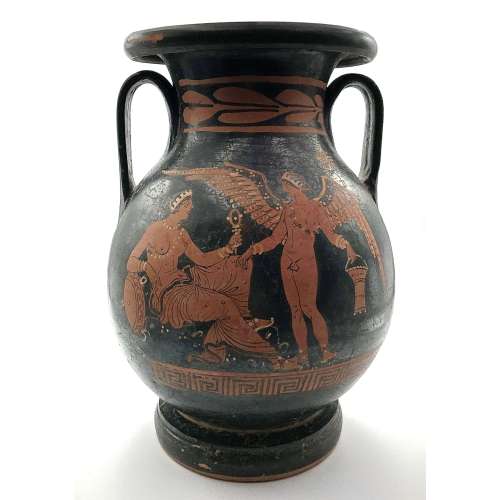 Seller provided description:"Finely painted via the red-figure technique, an elegant pelike vessel of a classic globular form with a cylindrical neck rising to a flared rim, and twin fluted handles, all upon a raised, concave, disc foot.Side A depicts a winged Eros who stands in contrapposto facing toward the left, in the nude save sandals, bracelets, a beaded sash, and a stephane (wreath) holding a situla (pail) in his left hand and gesturing toward the seated maenad before him. Though with her breasts exposed, the maenad does wear a lower garment, and is bedecked with a stephane, multiple bracelets, and strands of pearls around her neck - all delineated in fugitive white and yellow pigment. She holds a mirror in her left upraised hand and leans upon a tambourine with her right elbow. Above and to the right is a maker's mark of a circular format with a central X that is further adorned by nested wedges and dot motifs. Side B presents two opposing standing draped male figures, the gent on the left leaning upon a walking stick. Complementing the figural program, is a lovely decorative program adorning both sides of the vessel, with bands of laurel leaves above and a repeating Greek key/meander below. An outstanding example, masterfully wheel thrown, so that we see absolutely no signs of any jogs in the transitions between the different elements of the vase. Moreover, it presents ideal proportions perfect for presenting the superb painted iconographic/decorative program. The painting was executed with the utmost skill and artistry - the red-figure technique enabling the artist to delineate the figures' musculature, facial details, as well as the cascading drapery folds with extensive fugitive paint embellishments.Expected surface wear with some scuffs and pigment losses commensurate with age, but the painted program is generally very well preserved. Area of repair/restoration to cloak of male on right (Side B). Minute nick to left of male on left (Side B). Nice root marks throughout and areas of encrustation. Thermoluminescence (TL) report: the piece has been found to be ancient and of the period stated. Equivalent age: 2400 +/- 300 years. Certificate of Authenticity from Artemis Gallery. Provenance: private East Coast, USA collection. Greece, Southern Italy, Apulia, ca. 330 BCE.Size: 6.75" in diameter x 9.875" H (17.1 cm x 25.1 cm)Polina de Mauny, being both attentive and knowledgeable, was the first who noticed a possible mistake in the description above. It is highly probable that the woman on side A is not a maenad but Aphrodite herself, holding a mirror and leaning on a shield. Maenads were "often portrayed as inspired by Dionysus into a state of ecstatic frenzy through a combination of dancing and intoxication". The situla, held by Eros, unequivocally alludes to Dionysian ritual, which has to do as much with maenads as with Aphrodite. The nature of two men on side B remain unclear.
Seller provided description:"Finely painted via the red-figure technique, an elegant pelike vessel of a classic globular form with a cylindrical neck rising to a flared rim, and twin fluted handles, all upon a raised, concave, disc foot.Side A depicts a winged Eros who stands in contrapposto facing toward the left, in the nude save sandals, bracelets, a beaded sash, and a stephane (wreath) holding a situla (pail) in his left hand and gesturing toward the seated maenad before him. Though with her breasts exposed, the maenad does wear a lower garment, and is bedecked with a stephane, multiple bracelets, and strands of pearls around her neck - all delineated in fugitive white and yellow pigment. She holds a mirror in her left upraised hand and leans upon a tambourine with her right elbow. Above and to the right is a maker's mark of a circular format with a central X that is further adorned by nested wedges and dot motifs. Side B presents two opposing standing draped male figures, the gent on the left leaning upon a walking stick. Complementing the figural program, is a lovely decorative program adorning both sides of the vessel, with bands of laurel leaves above and a repeating Greek key/meander below. An outstanding example, masterfully wheel thrown, so that we see absolutely no signs of any jogs in the transitions between the different elements of the vase. Moreover, it presents ideal proportions perfect for presenting the superb painted iconographic/decorative program. The painting was executed with the utmost skill and artistry - the red-figure technique enabling the artist to delineate the figures' musculature, facial details, as well as the cascading drapery folds with extensive fugitive paint embellishments.Expected surface wear with some scuffs and pigment losses commensurate with age, but the painted program is generally very well preserved. Area of repair/restoration to cloak of male on right (Side B). Minute nick to left of male on left (Side B). Nice root marks throughout and areas of encrustation. Thermoluminescence (TL) report: the piece has been found to be ancient and of the period stated. Equivalent age: 2400 +/- 300 years. Certificate of Authenticity from Artemis Gallery. Provenance: private East Coast, USA collection. Greece, Southern Italy, Apulia, ca. 330 BCE.Size: 6.75" in diameter x 9.875" H (17.1 cm x 25.1 cm)Polina de Mauny, being both attentive and knowledgeable, was the first who noticed a possible mistake in the description above. It is highly probable that the woman on side A is not a maenad but Aphrodite herself, holding a mirror and leaning on a shield. Maenads were "often portrayed as inspired by Dionysus into a state of ecstatic frenzy through a combination of dancing and intoxication". The situla, held by Eros, unequivocally alludes to Dionysian ritual, which has to do as much with maenads as with Aphrodite. The nature of two men on side B remain unclear. -
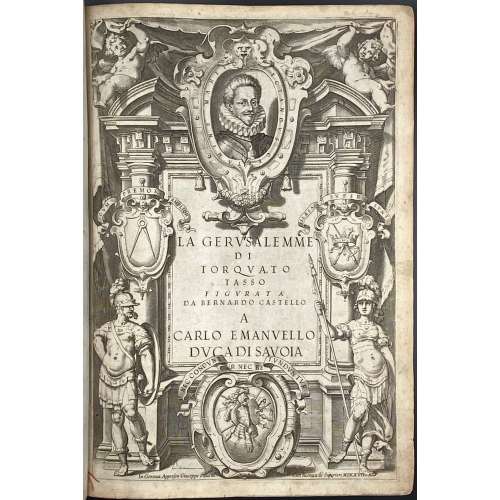 Engraved title-page 1, as per British Museum: An architectural setting with, at upper centre, a portrait of Carlo Emanuele I, Duke of Savoy, in an ornate cartouche lettered “"Spectandus Certamine Martio"; a central title “LA | GERUSALEMME | DI | TORQUATO | TASSO | FUGURATA A | DA BERNARDO CASTELLO | A | CARLO EMANUELLO | DVCA DI SAVOIA” flanked by Tuscan columns and crests with mottos and imprese showing compasses lettered "Dvm Premor Amplior", at left, and a crossed sword and sceptre with a crown lettered "Illaesa Super Sunt", at right; in the lower register, male and female figures in armour, perhaps representing Tancredi and Clorinda, with a central crest showing an impresa of armour”. Central title: Below, within frame: "In Genova, Appresso Giuseppe Pavoni. […] Con licenza de' Superiori. MDCXVII." Engraved title-page 2, as per British Museum: Portrait of Torquato Tasso, bust, facing front, wearing a laurel crown; within an oval pendant, lettered “TOROVATO […] TASSO EF”, suspended from a pediment, beneath which a view of Genoa is flanked by two columns, and above is a tablet, lettered: “LA GERUSALEMME | LIBERATA | DI TORQUATO | TASSO. | Con le annotazioni | di Scipion | Gentili, e di Givlio | Guastauini , | Et li argomenti di Oratio Ariosti , | STAMPATA | Per Giuseppe Pauoni ad instanza di | Bernardo Castello,in Genova | L’Anno MDCXVII." Collation: 8vo; 2 leaves of engraved title-pages, 1 leaf signed †2, 1 leaf unsigned, 2 leaves signed †† and ††2, respectively, 1 leaf unsigned, 1 leaf with engraving to verso (frontispiece to Canto Primo) —> 8 prelims (besides FEP or a blank leaf before 1st t.p.); π8 A-Q8 (pp. 1-255 [256 blank], plated within collation), G1, I1, K1, O1, and P1 (recto to plates without text) unsigned, L3 signed as second L2; A-D8 E4 (pp. 1-71 [72]; A-B8 C4 χ1 (pp. [1] 2-36 [37-40] [2]), in the 4-leaf quires E and C only two first leaves signed, in the 8-leaf quires four first leaves signed. Illustrations: woodcut head- and tail-pieces, woodcut initials, some historiated, and 20 plates within collation and pagination engraved by Camillo Cungio after Bernardo Castello. Binding: 30.5 x 21.4 cm overall, 30 x 20.5 cm leaves; contemporary vellum, rebacked with modern brown morocco, crimson morocco label with gilt lettering and double-fillet outline. Two bookplates to front pastedown: (1) Chippendale armorial bookplate (8.3 x 7.6 cm): Thos. Brand Esqr. Signed: W Austin — Fecit; (2) The Robin Collection bookplate. Bookseller’s ticket to back pastedown: “J. POOLE. | British & foreign | BOOKSELLER, | 39 BOOKSELLERS ROW, | STRAND |〰️| Books Bought.” All edges green. Provenance: The Robin Collection; Thomas Brand Hollis (British, 1719 – 1804). Contributors: Torquato Tasso (Italian, 1544 –1595) – author. Scipione Gentili [Scipio Gentilis] (Italian, 1563 – 1616) – author. Giulio Guastavini (Italian, fl. 16th century) – author. Bernardo Castello [Castelli] (Italian, 1557 – 1629) – artist. Camillo Cungi (Italian, fl. 1597 – 1649) – engraver. Giuseppe Pavoni (Italian, 1551 – c. 1641) – printer, publisher. Carlo Emanuele I, Duke of Savoy (Italian, 1562 – 1630) – dedicatee.
Engraved title-page 1, as per British Museum: An architectural setting with, at upper centre, a portrait of Carlo Emanuele I, Duke of Savoy, in an ornate cartouche lettered “"Spectandus Certamine Martio"; a central title “LA | GERUSALEMME | DI | TORQUATO | TASSO | FUGURATA A | DA BERNARDO CASTELLO | A | CARLO EMANUELLO | DVCA DI SAVOIA” flanked by Tuscan columns and crests with mottos and imprese showing compasses lettered "Dvm Premor Amplior", at left, and a crossed sword and sceptre with a crown lettered "Illaesa Super Sunt", at right; in the lower register, male and female figures in armour, perhaps representing Tancredi and Clorinda, with a central crest showing an impresa of armour”. Central title: Below, within frame: "In Genova, Appresso Giuseppe Pavoni. […] Con licenza de' Superiori. MDCXVII." Engraved title-page 2, as per British Museum: Portrait of Torquato Tasso, bust, facing front, wearing a laurel crown; within an oval pendant, lettered “TOROVATO […] TASSO EF”, suspended from a pediment, beneath which a view of Genoa is flanked by two columns, and above is a tablet, lettered: “LA GERUSALEMME | LIBERATA | DI TORQUATO | TASSO. | Con le annotazioni | di Scipion | Gentili, e di Givlio | Guastauini , | Et li argomenti di Oratio Ariosti , | STAMPATA | Per Giuseppe Pauoni ad instanza di | Bernardo Castello,in Genova | L’Anno MDCXVII." Collation: 8vo; 2 leaves of engraved title-pages, 1 leaf signed †2, 1 leaf unsigned, 2 leaves signed †† and ††2, respectively, 1 leaf unsigned, 1 leaf with engraving to verso (frontispiece to Canto Primo) —> 8 prelims (besides FEP or a blank leaf before 1st t.p.); π8 A-Q8 (pp. 1-255 [256 blank], plated within collation), G1, I1, K1, O1, and P1 (recto to plates without text) unsigned, L3 signed as second L2; A-D8 E4 (pp. 1-71 [72]; A-B8 C4 χ1 (pp. [1] 2-36 [37-40] [2]), in the 4-leaf quires E and C only two first leaves signed, in the 8-leaf quires four first leaves signed. Illustrations: woodcut head- and tail-pieces, woodcut initials, some historiated, and 20 plates within collation and pagination engraved by Camillo Cungio after Bernardo Castello. Binding: 30.5 x 21.4 cm overall, 30 x 20.5 cm leaves; contemporary vellum, rebacked with modern brown morocco, crimson morocco label with gilt lettering and double-fillet outline. Two bookplates to front pastedown: (1) Chippendale armorial bookplate (8.3 x 7.6 cm): Thos. Brand Esqr. Signed: W Austin — Fecit; (2) The Robin Collection bookplate. Bookseller’s ticket to back pastedown: “J. POOLE. | British & foreign | BOOKSELLER, | 39 BOOKSELLERS ROW, | STRAND |〰️| Books Bought.” All edges green. Provenance: The Robin Collection; Thomas Brand Hollis (British, 1719 – 1804). Contributors: Torquato Tasso (Italian, 1544 –1595) – author. Scipione Gentili [Scipio Gentilis] (Italian, 1563 – 1616) – author. Giulio Guastavini (Italian, fl. 16th century) – author. Bernardo Castello [Castelli] (Italian, 1557 – 1629) – artist. Camillo Cungi (Italian, fl. 1597 – 1649) – engraver. Giuseppe Pavoni (Italian, 1551 – c. 1641) – printer, publisher. Carlo Emanuele I, Duke of Savoy (Italian, 1562 – 1630) – dedicatee. -
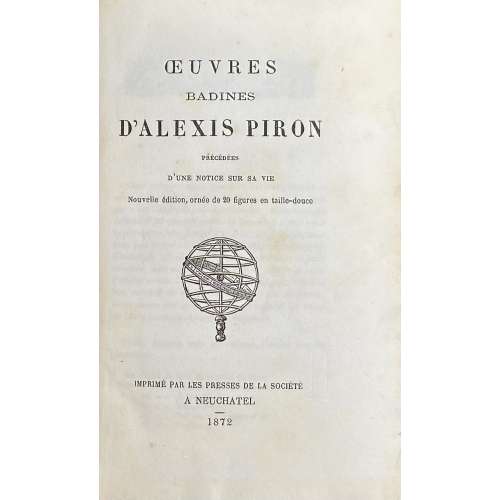 Single volume, 17.1 x 11.2 cm, quarter black sheepskin over faux chagrin, gilt lettering to spine, marbled endpapers, bottom and outer margin untrimmed, pp.: [i-v] vi- xxxvi, [1] 2-218 [2], collated 4to: π2, a-d4, 1-274 282, total 256 pages or 128 leaves, plus 20 engraved plates by Paul Sellier, including frontispiece portrait of Alexis Piron after bust by Caffieri. Vol. 8 of Bibliothèque Libre, Œuvres badines de Piron, printed on February 15, 1872. Text printed on dense wove paper watermarked P or M, plates printed on India wove paper. A reprint of an edition published in 1796 plus illustrations. Title-page: ŒUVRES | BADINES | D’ALEXIS PIRON | PRÉCÉDÉES | D’UNE NOTICE SUR SA VIE | Nouvelle édition, ornée de 20 figures en taille-douce | {vignette} | IMPRIMÉ PAR LES PRESSES DE LA SOCIÉTÉ | A NEUCHATEL | – | 1872 || Limitation: 100 numbered copies, of which this is № 75. Catalogue raisonné: Dutel I: A-788; Pia: 953-6; Kearney 377 (Patrick J. Kearney. A Catalogue of the publications of Jules Gay, Jean-Jules Gay & Gay et Doucé, revised & expanded. — Santa Rosa, CA Scissors & Paste Bibliographies, 2019) Catalogue Poulet-Malassis & ses amis description: № 81. Alexis PIRON. Œuvres badines précédées d’une notice sur sa vie. Nouvelle édition ornée de 20 figures en taille-douce. [ Jules Gay] Imprimé par les presses de la société, à Neufchatel, 1872. In-8, xxxvi, 218 pages et un feuillet d’achevé d’imprimer de table, demi-basane noire, dos à faux nerfs, tête et tranches naturelles. Illustré d’un portrait et de 20 figures par Paul Sellier. Tirage limité à 100 ex. numérotés. De la « Bibliothèque libre ou collection choisie d’ouvrages du genre libre, imprimés ou réimprimés par les soins de la Société des Bibliophiles Cosmopolites et pour les membres de cette société, à cent exemplaires numérotés ». Bibliographie : Pia 1030, Enfer 1274, Lem 3-454, Gay 5-339, PC 353, G* 38, Pey 203, Dutel A-788." Contributors: Alexis Piron (French, 1689 – 1773) – author. Paul Sellier (French, 1842 – 19..?) – artist. Jules Léopold Gay (French, 1807 – 1887) – publisher.
Single volume, 17.1 x 11.2 cm, quarter black sheepskin over faux chagrin, gilt lettering to spine, marbled endpapers, bottom and outer margin untrimmed, pp.: [i-v] vi- xxxvi, [1] 2-218 [2], collated 4to: π2, a-d4, 1-274 282, total 256 pages or 128 leaves, plus 20 engraved plates by Paul Sellier, including frontispiece portrait of Alexis Piron after bust by Caffieri. Vol. 8 of Bibliothèque Libre, Œuvres badines de Piron, printed on February 15, 1872. Text printed on dense wove paper watermarked P or M, plates printed on India wove paper. A reprint of an edition published in 1796 plus illustrations. Title-page: ŒUVRES | BADINES | D’ALEXIS PIRON | PRÉCÉDÉES | D’UNE NOTICE SUR SA VIE | Nouvelle édition, ornée de 20 figures en taille-douce | {vignette} | IMPRIMÉ PAR LES PRESSES DE LA SOCIÉTÉ | A NEUCHATEL | – | 1872 || Limitation: 100 numbered copies, of which this is № 75. Catalogue raisonné: Dutel I: A-788; Pia: 953-6; Kearney 377 (Patrick J. Kearney. A Catalogue of the publications of Jules Gay, Jean-Jules Gay & Gay et Doucé, revised & expanded. — Santa Rosa, CA Scissors & Paste Bibliographies, 2019) Catalogue Poulet-Malassis & ses amis description: № 81. Alexis PIRON. Œuvres badines précédées d’une notice sur sa vie. Nouvelle édition ornée de 20 figures en taille-douce. [ Jules Gay] Imprimé par les presses de la société, à Neufchatel, 1872. In-8, xxxvi, 218 pages et un feuillet d’achevé d’imprimer de table, demi-basane noire, dos à faux nerfs, tête et tranches naturelles. Illustré d’un portrait et de 20 figures par Paul Sellier. Tirage limité à 100 ex. numérotés. De la « Bibliothèque libre ou collection choisie d’ouvrages du genre libre, imprimés ou réimprimés par les soins de la Société des Bibliophiles Cosmopolites et pour les membres de cette société, à cent exemplaires numérotés ». Bibliographie : Pia 1030, Enfer 1274, Lem 3-454, Gay 5-339, PC 353, G* 38, Pey 203, Dutel A-788." Contributors: Alexis Piron (French, 1689 – 1773) – author. Paul Sellier (French, 1842 – 19..?) – artist. Jules Léopold Gay (French, 1807 – 1887) – publisher. -
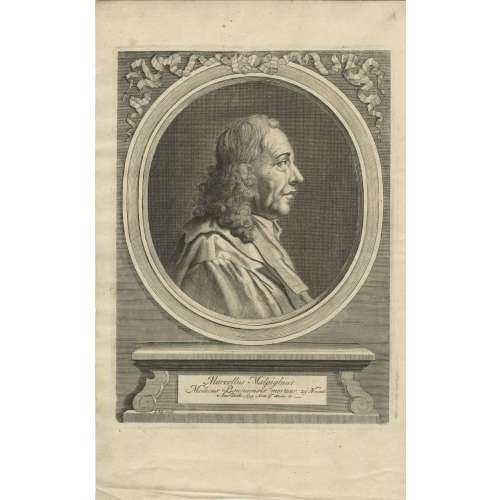
A portrait of Marcello Malpighi from his book Opera posthuma: figuris aeneis illustrata, quibus praefixa est ejusdem vita a seipso scripta, Londini:Churchill, 1697. Inscription: Marcellus Malpighius | Medicus Bononiensis mortuus 29 Novemb. Anno Dom. 1694. Anno aetatis 67. I. Kip. sculp.
Marcello Malpighi (10 March 1628 – 29 November 1694) was an Italian biologist and physician, who is referred to as the "Father of microscopical anatomy, histology, physiology and embryology" [Wikipedia].
From European Journal of Anatomy 22(5):433-439 · September 2018, an article by Sanjib Ghosh and Ashutosh Kumar 'Marcello Malpighi (1628-1694): Pioneer of microscopic anatomy and exponent of the scientific revolution of the 17th Century': Italian anatomist and an eminent scientist who significantly contributed to the advancement of the anatomical sciences in the 17th century. Malpighi was one of the first to use the compound microscope (an instrument designed by Galileo in 1609) and made the most important discovery of his life in 1661 when he identified capillaries as connecting vessels between small arteries and veins in the lungs. Malpighi thus provided the missing link in William Harvey's theory of blood circulation. He made significant contributions in the field of embryology based on his observations on chick embryo, and his efforts provided deep insights into the development of the heart and the nervous system. His communications based on microscopic studies scripted valuable details on the structural organization of organs like the liver, kidney and spleen. He identified the hepatic lobule as the fundamental unit of the liver and noted that bile was being secreted by these lobules and not from the gall bladder (the popular belief then). In the kidney, he discovered the glomerulus (Malpighian Corpuscle) and was the first to observe the convoluted tubules in the renal cortex. He was the first to describe the presence of lymphatic bodies (Malpighi's Corpuscle) in the spleen. Although he was exceedingly successful in his scientific activities, his life was fraught with unfortunate events and savage criticism from detractors arising out of professional jealousy and personal feuds. Nevertheless, his exploits were instrumental in understanding the human microscopic anatomy (histology) and his accomplishments have etched his name in the pages of medical science forever.
The portrait was engraved by Johannes "Jan" Kip (1652/53, Amsterdam – 1722, Westminster) - a Dutch draftsman, engraver and print dealer.
-
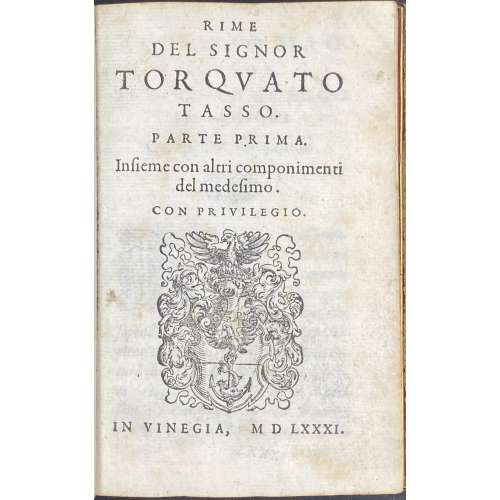 Title-page: RIME | DEL SIGNOR | TORQUATO | TASSO. | PARTE PRIMA. | Insieme con altri componimenti | del medesimo | CON PRIVILEGIO. | {publisher’s device} | IN VINEGIA, M D LXXXI. || Contents: 1. Rime; 2. Aminta favola boscareccia; 3. Conclusioni amorose; 4. Il Romeo, overo del Giuoco dialogo; 5. Lettera, nellaquale paragona l’Italia alla Francia; 6. All’eccellentis signor Duca di Urbino; 7. Dialogo del l’amor. Pagination: [2 blanks], [2] – t.p. / blank, [4] dedication, [2] – blank / content, [16] – tavola, [1] 2-160 – rime, [8] [1] 2-74 – aminta, [4] 1-9 [10 blank] – conclusion, [2] [1]-22 – dialogo, [2] 1-27 [28 blank] – lettera, [2] 1-4 – all’eccellentiss, [4 blanks], [2] 1-17 [18 blank] – dialogo del l’amor, [2] – Car. 52 / Car. 113., [4 blanks], total 372 pages. Collation: 8vo; first blank, *4, **8, A-K8, 2A-2L8 M4, last blank; total 186 leaves, incl. first and last blanks. Note: 2F2, 2G1, 2K4, 2L1, and 2M3,4 – unsigned. Binding: 15.2 x 10.3 cm, 19th-century polished calf by Duke St., St. James, London (ticket) Cambridge panels ruled in gilt with fleurons at corners, two crimson labels to spine with gilt lettering, gilt in compartments, raised bands ruled gilt, rebacked, AEG, bookplate to front pastedown: “BIBLIOTECA | del | Conte Leonardo Vitetti | Ambasciatore d’Italia” in a frame, and “The Robin Collection” to FEP. Inset a card from Bryn Mawr College Library. Provenance: Satinsky, Robin F. (American, 1919 – 2008), The Robin Collection. Count Leonardo Vitetti (Italian, 1895 – 1973) Bryn Mawr College Library (Pennsylvania) Contributors: Torquato Tasso (Italian, 1544 –1595) – author. Aldus Manutius, the Younger (Italian, 1547 – 1597) – printer, publisher.
Title-page: RIME | DEL SIGNOR | TORQUATO | TASSO. | PARTE PRIMA. | Insieme con altri componimenti | del medesimo | CON PRIVILEGIO. | {publisher’s device} | IN VINEGIA, M D LXXXI. || Contents: 1. Rime; 2. Aminta favola boscareccia; 3. Conclusioni amorose; 4. Il Romeo, overo del Giuoco dialogo; 5. Lettera, nellaquale paragona l’Italia alla Francia; 6. All’eccellentis signor Duca di Urbino; 7. Dialogo del l’amor. Pagination: [2 blanks], [2] – t.p. / blank, [4] dedication, [2] – blank / content, [16] – tavola, [1] 2-160 – rime, [8] [1] 2-74 – aminta, [4] 1-9 [10 blank] – conclusion, [2] [1]-22 – dialogo, [2] 1-27 [28 blank] – lettera, [2] 1-4 – all’eccellentiss, [4 blanks], [2] 1-17 [18 blank] – dialogo del l’amor, [2] – Car. 52 / Car. 113., [4 blanks], total 372 pages. Collation: 8vo; first blank, *4, **8, A-K8, 2A-2L8 M4, last blank; total 186 leaves, incl. first and last blanks. Note: 2F2, 2G1, 2K4, 2L1, and 2M3,4 – unsigned. Binding: 15.2 x 10.3 cm, 19th-century polished calf by Duke St., St. James, London (ticket) Cambridge panels ruled in gilt with fleurons at corners, two crimson labels to spine with gilt lettering, gilt in compartments, raised bands ruled gilt, rebacked, AEG, bookplate to front pastedown: “BIBLIOTECA | del | Conte Leonardo Vitetti | Ambasciatore d’Italia” in a frame, and “The Robin Collection” to FEP. Inset a card from Bryn Mawr College Library. Provenance: Satinsky, Robin F. (American, 1919 – 2008), The Robin Collection. Count Leonardo Vitetti (Italian, 1895 – 1973) Bryn Mawr College Library (Pennsylvania) Contributors: Torquato Tasso (Italian, 1544 –1595) – author. Aldus Manutius, the Younger (Italian, 1547 – 1597) – printer, publisher.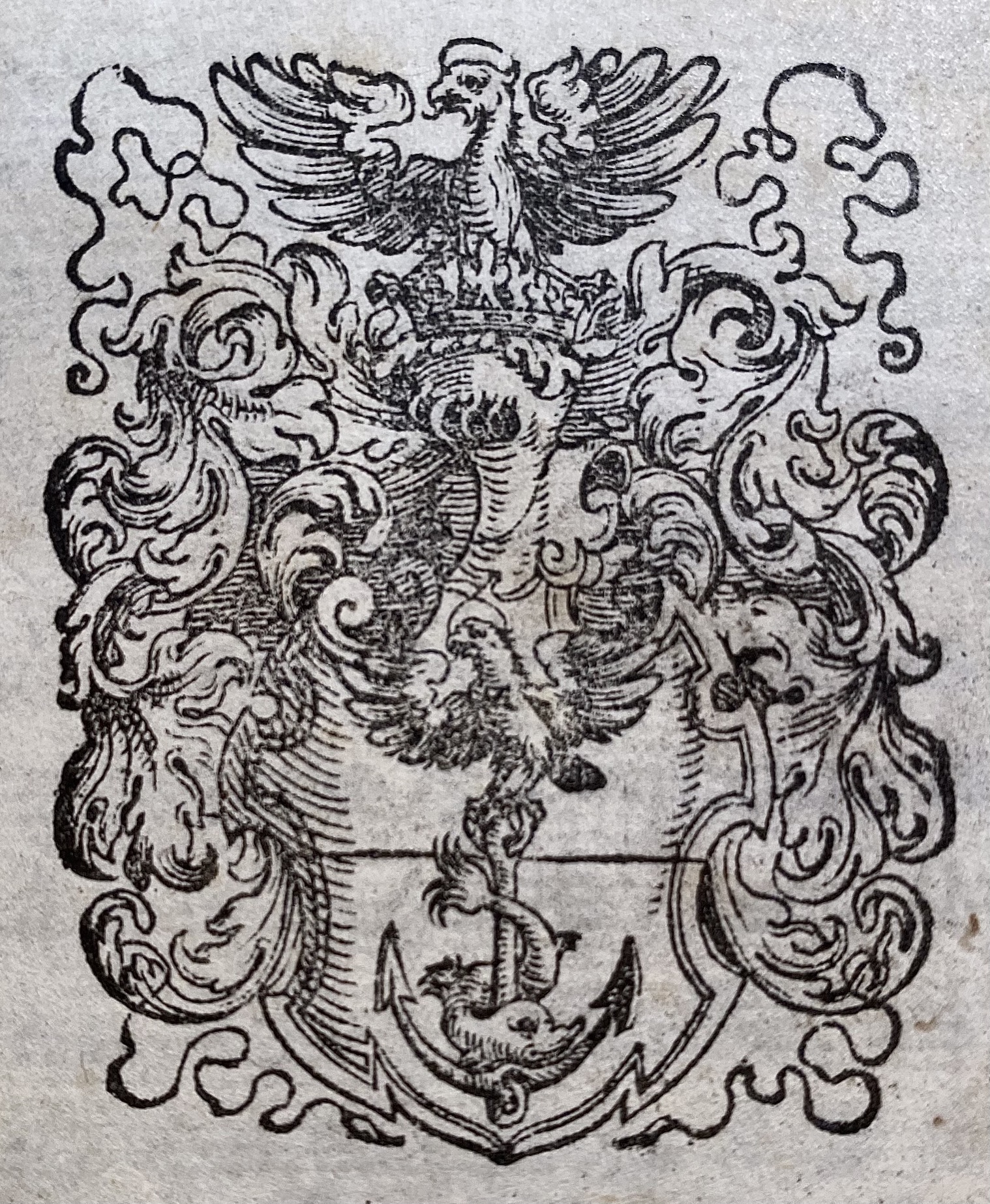
-
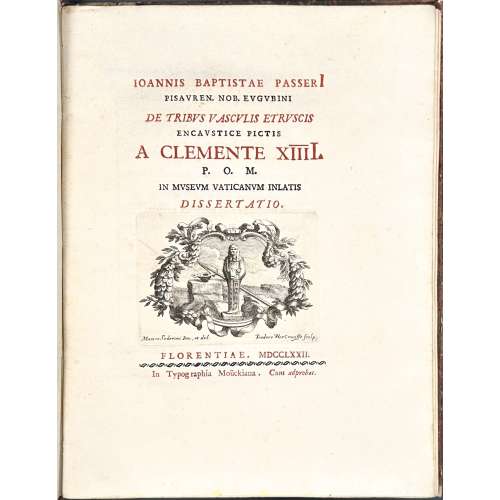 Owner’s wrappers, 28 x 21 cm, printed on laid paper, unpaginated, collated ffl, [A, B]4 C-G4, 2 ffl; total 28 leaves plus 5 engraved plates by Allegrini after Mariotti; engraved title-page (Vercruys after Soderini), head- and tailpieces (Gregori after del Moro) and initials. Owner's label to front pastedown: Marc Burdin, prêtre. Title-page (engraved, red and black): IOANNIS BAPTISTAE PASSERI | PISAUREN. NOB. EUGUBINI | DE TRIBUS VASCULIS ETRUSCIS | ENCAUSTICE PICTIS | A CLEMENTE XIIII. | P.O.M. | IN MUSEUM VATICANUM INLATIS | DISSERTATIO. | {VIGNETTE} | FLORENTIAE. MDCCLXXII. | ~ | in Typographia Moückiana. Cum adprobat. || Dedication: ANTIQVARIAE. ERVDITIONIS. PROPAGATORI EXIMIO ABSOLVTISSIMAM . HANC. DISSERTATIONEM CLARISS. PASSERII DE . IMAGINIBVS . ET . SYMBOLIS TRIVM . VASORVM . ETRVSCI . OPERIS QVAE PRINCIPIS. NOSTRI.SANCTISS. ET. SAPIENTISS. LARGITATE IN . VATICANVM . MVSEVM A. SE. CVMVLATISSIME . DITATVM INVE CTA . FVERVNT REGINALDVS.COMES.ANSIDAEVS.PATR.PERVS. M. A. CARD. PRONEPOS DEVOTVS. NOMINI . MAIESTATIQVE . EIVS DEMISSISSIME. Translation: "To the most excellent promoter of antiquities, the most accomplished: This most complete dissertation concerning the images and symbols of three Etruscan vases, which were most abundantly bestowed by our most holy and wise Prince onto the Vatican museum, was composed by the illustrious Passerius. Reginald, Count of Ansidius, true ancestral father, grandson by blood of the Cardinal, devoted most humbly and devoutly to his name and majesty." Note: P.O.M. stands for "Papa Optimo Maximo", which translates to "Father Most Excellent." For a similar vase in this collection, see VO-0098.
Owner’s wrappers, 28 x 21 cm, printed on laid paper, unpaginated, collated ffl, [A, B]4 C-G4, 2 ffl; total 28 leaves plus 5 engraved plates by Allegrini after Mariotti; engraved title-page (Vercruys after Soderini), head- and tailpieces (Gregori after del Moro) and initials. Owner's label to front pastedown: Marc Burdin, prêtre. Title-page (engraved, red and black): IOANNIS BAPTISTAE PASSERI | PISAUREN. NOB. EUGUBINI | DE TRIBUS VASCULIS ETRUSCIS | ENCAUSTICE PICTIS | A CLEMENTE XIIII. | P.O.M. | IN MUSEUM VATICANUM INLATIS | DISSERTATIO. | {VIGNETTE} | FLORENTIAE. MDCCLXXII. | ~ | in Typographia Moückiana. Cum adprobat. || Dedication: ANTIQVARIAE. ERVDITIONIS. PROPAGATORI EXIMIO ABSOLVTISSIMAM . HANC. DISSERTATIONEM CLARISS. PASSERII DE . IMAGINIBVS . ET . SYMBOLIS TRIVM . VASORVM . ETRVSCI . OPERIS QVAE PRINCIPIS. NOSTRI.SANCTISS. ET. SAPIENTISS. LARGITATE IN . VATICANVM . MVSEVM A. SE. CVMVLATISSIME . DITATVM INVE CTA . FVERVNT REGINALDVS.COMES.ANSIDAEVS.PATR.PERVS. M. A. CARD. PRONEPOS DEVOTVS. NOMINI . MAIESTATIQVE . EIVS DEMISSISSIME. Translation: "To the most excellent promoter of antiquities, the most accomplished: This most complete dissertation concerning the images and symbols of three Etruscan vases, which were most abundantly bestowed by our most holy and wise Prince onto the Vatican museum, was composed by the illustrious Passerius. Reginald, Count of Ansidius, true ancestral father, grandson by blood of the Cardinal, devoted most humbly and devoutly to his name and majesty." Note: P.O.M. stands for "Papa Optimo Maximo", which translates to "Father Most Excellent." For a similar vase in this collection, see VO-0098.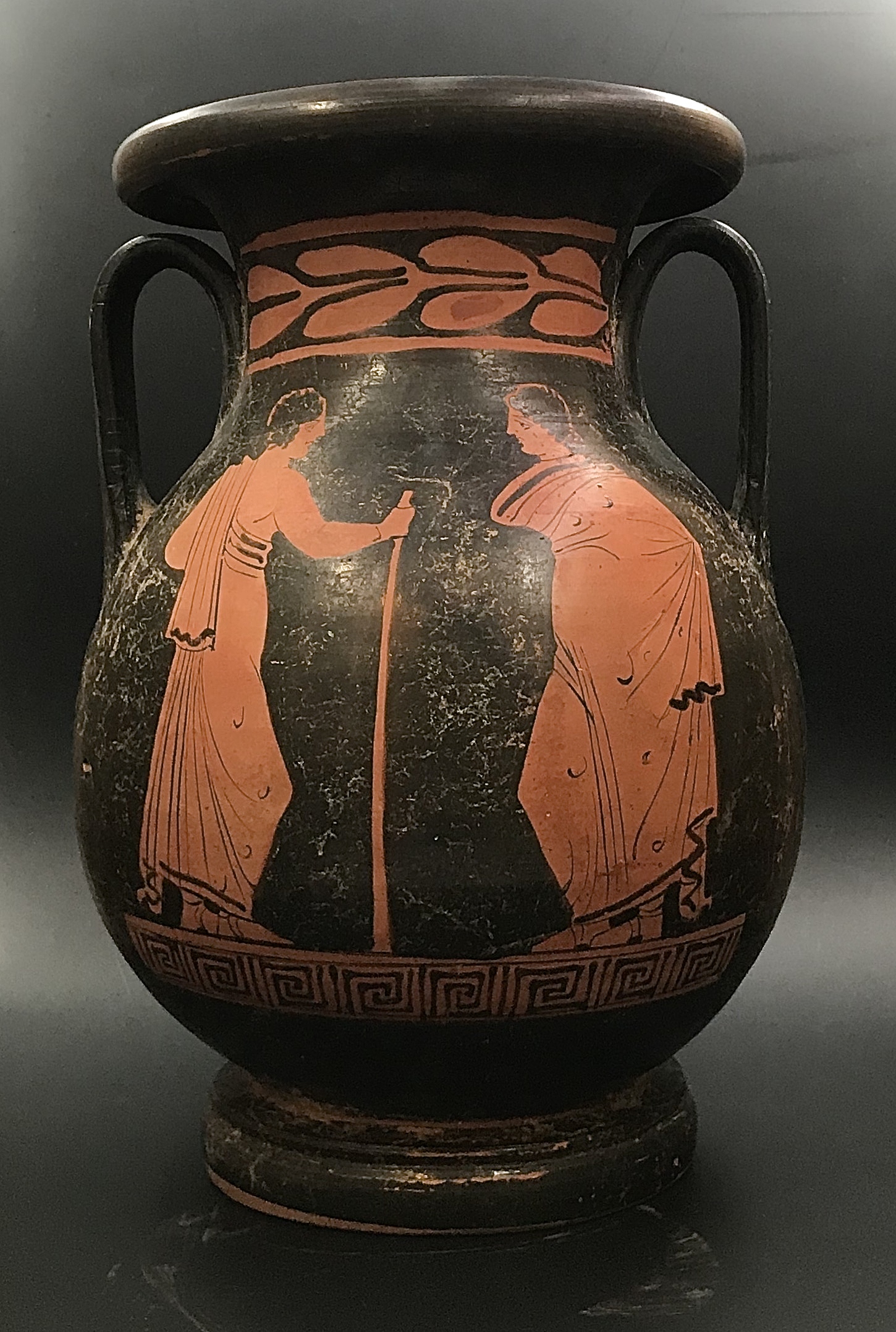
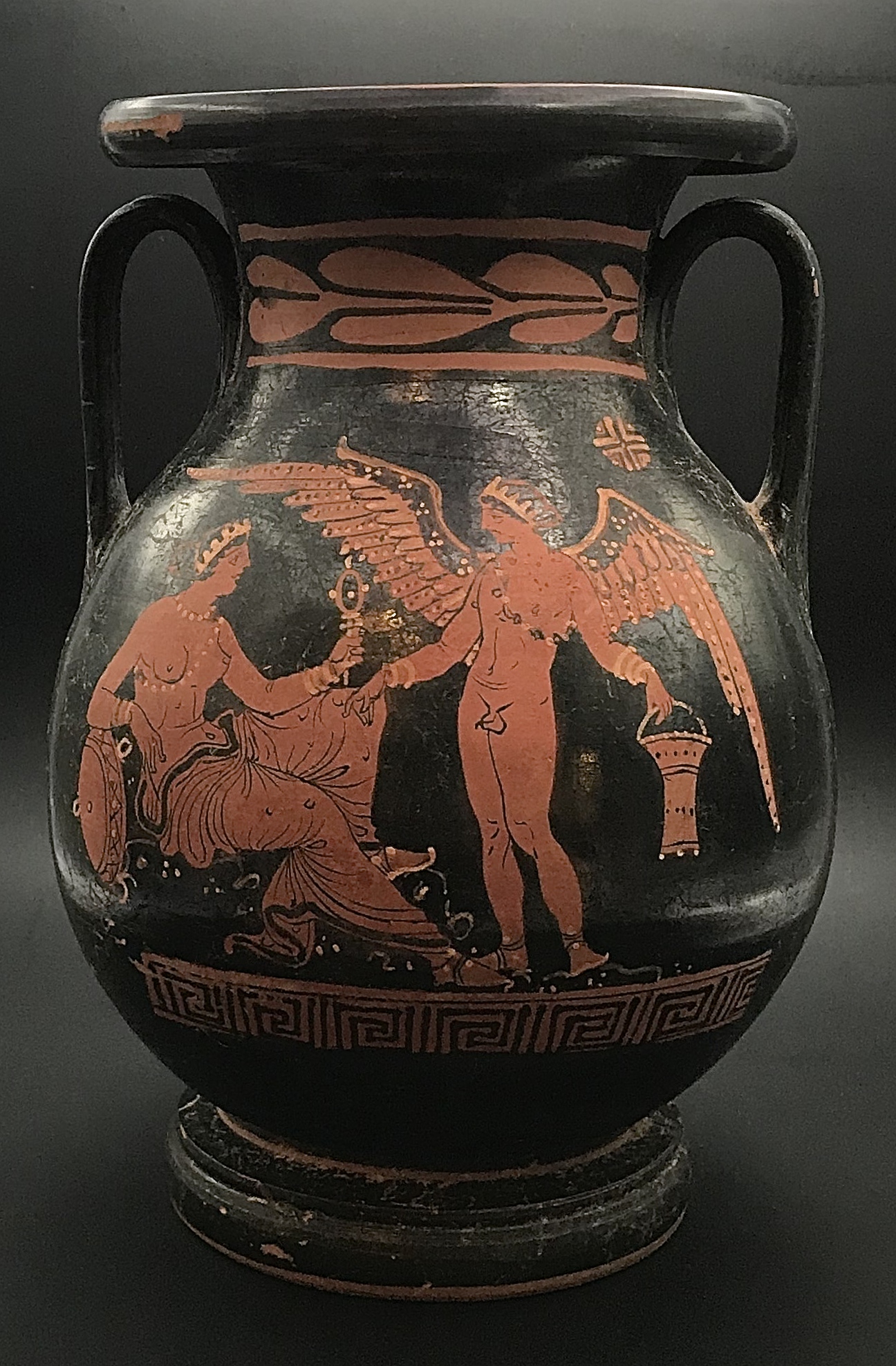 This vase is attributed to Apulia, ca. 330 BCE. Passeri was probably wrong to attribute this type of vessel to Etruscan vase painting, produced from the 7th through the 4th centuries BC.
Contributors:
Giovanni Battista Passeri (Italian, 1694 – 1780) – author.
Francesco Moücke (Italian, fl. 1729 – 1787) – publisher.
Pope Clement XIV [Ganganelli, Giovanni Vincenzo Antonio] (Italian, 1705 – 1774) – dedicatee.
Artists:
Mauro Soderini (Italian, 1704 – after 1751)
Carlo Spiridione Mariotti (Italian, 1726 – 1790)
Lorenzo del Moro (Italian, 1677 – 1735)
Engravers:
Theodor Vercruys [Teodoro Vercruysse] (Dutch, 1678 – 1739)
Francesco Allegrini da Gubbio (Italian, 1587 – 1663)
Carlo Bartolomeo Gregori (Italian, 1702 – 1759)
This vase is attributed to Apulia, ca. 330 BCE. Passeri was probably wrong to attribute this type of vessel to Etruscan vase painting, produced from the 7th through the 4th centuries BC.
Contributors:
Giovanni Battista Passeri (Italian, 1694 – 1780) – author.
Francesco Moücke (Italian, fl. 1729 – 1787) – publisher.
Pope Clement XIV [Ganganelli, Giovanni Vincenzo Antonio] (Italian, 1705 – 1774) – dedicatee.
Artists:
Mauro Soderini (Italian, 1704 – after 1751)
Carlo Spiridione Mariotti (Italian, 1726 – 1790)
Lorenzo del Moro (Italian, 1677 – 1735)
Engravers:
Theodor Vercruys [Teodoro Vercruysse] (Dutch, 1678 – 1739)
Francesco Allegrini da Gubbio (Italian, 1587 – 1663)
Carlo Bartolomeo Gregori (Italian, 1702 – 1759)


